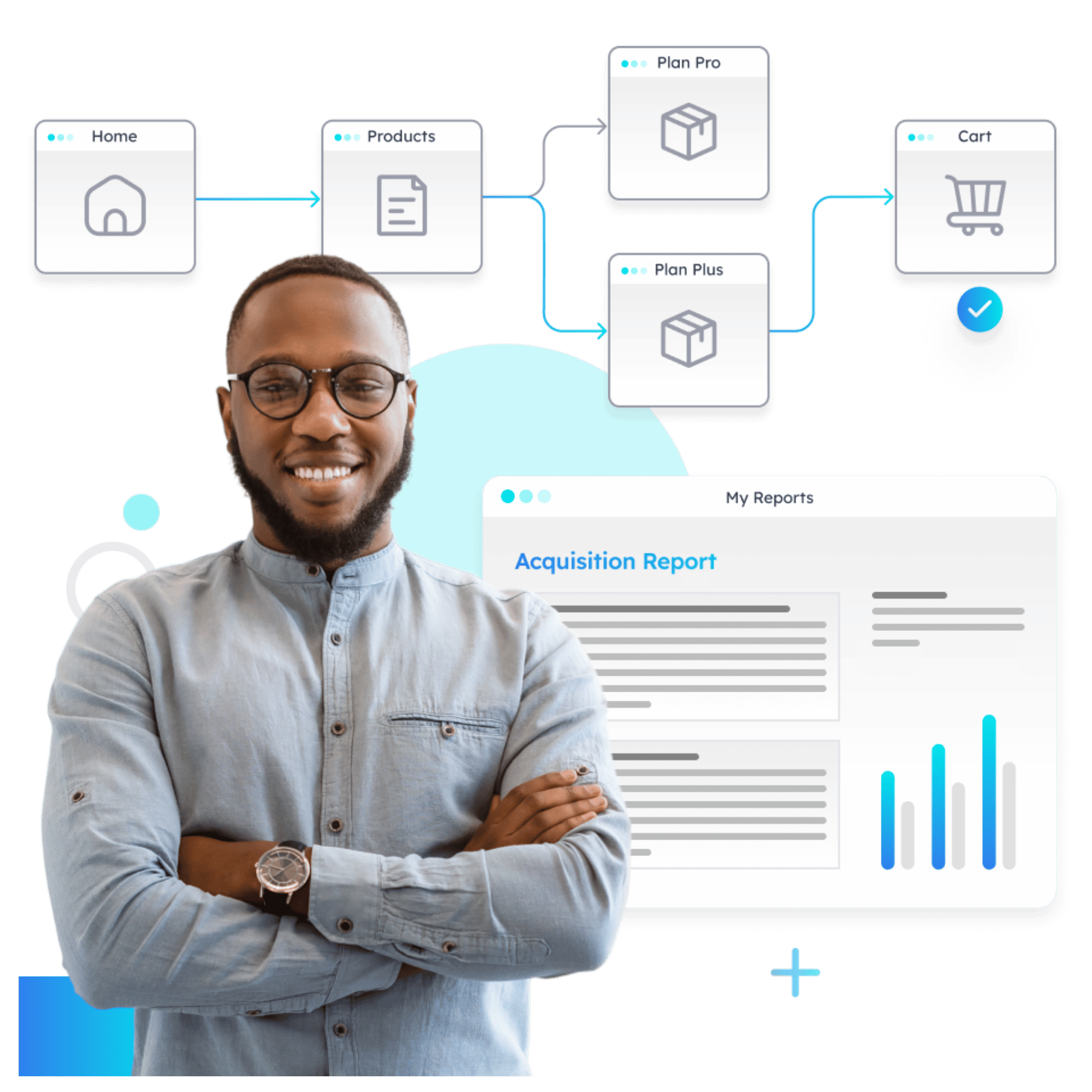
Product-led growth (PLG) is a business strategy that focuses on using the product itself as the primary driver of customer acquisition, conversion, and retention. In a product-led growth model, the product is designed to be self-serve and user-friendly, allowing users to easily discover, use, and derive value from it without the need for extensive sales or marketing efforts.
In this blog post we’re going to share insights into the three easiest product-led growth examples to replicate, allowing other businesses to draw inspiration and apply these proven approaches to enhance their own growth trajectories. These strategies have demonstrated success across various industries, showcasing their adaptability and effectiveness in driving customer acquisition, conversion, and retention through a product-centric approach.
Table of Contents
Key Principles and Characteristics of Product-Led Growth
- User-Centric Design: Products are designed with a strong emphasis on user experience, making it intuitive and easy for users to understand and leverage the product’s features.
- Freemium or Free Trials: Many product-led growth companies offer free versions of their products or free trial periods to allow users to experience the value before committing to a paid subscription.
- Viral Loops: Products are engineered to encourage existing users to refer new users, creating a self-perpetuating cycle of growth. This is often achieved through features that prompt users to invite others, share content, or collaborate within the product.
- Data-Driven Iteration: Companies employing a product-led growth strategy rely heavily on user data to understand how customers interact with their product. This data informs ongoing product development and marketing efforts. Investing in a robust analytics platform like Pathmonk Intelligence empowers organizations to track key performance indicators, measure the impact of product updates, and optimize marketing strategies.
Understand your customer journey analytics
See how your users behave, find drop-offs, and receive actionable insights with AI.

- Low-Touch Sales: Rather than relying on traditional high-touch sales processes, product-led growth companies often prioritize self-service sales models. Users can sign up, onboard, and upgrade to paid plans without direct sales interactions.
- Customer Onboarding and Education: Effective onboarding processes and in-product education help users quickly understand the value of the product, increasing the likelihood of user retention and expansion to paid plans.
- Scalable Customer Success: Automation and self-service support options are implemented to scale customer success efforts. This allows companies to efficiently support a growing user base without a proportional increase in support staff.
- Product Metrics Focus: Product-led growth companies closely monitor key product metrics such as user engagement, activation rates, and conversion rates to continuously improve the product and drive growth.
Examples of companies that have successfully implemented a product-led growth strategy include Slack, Dropbox, Zoom, Glovo, and Atlassian among others. These companies have demonstrated how a well-designed product, combined with strategic user acquisition and retention tactics, can fuel significant business growth.
Slack’s Product-Led Growth Strategy
Slack is widely recognized for its successful implementation of a product-led growth sales strategy, transforming the way teams communicate and collaborate in the workplace.
Freemium Model
Slack offers a freemium model, providing a free version with core features that allow teams to experience the product’s value. This approach encourages widespread adoption and allows users to upgrade to premium plans for additional features and advanced functionalities.
Intuitive User Onboarding
Slack is known for its user-friendly interface and intuitive onboarding process. New users can quickly set up their workspace, join channels, and start communicating without a steep learning curve.
Virality and Network Effects
Slack’s design encourages users to invite others to join their workspace, creating a viral loop. As more users join, the network effect amplifies the value of the platform, making it more attractive for new users.
Community Building
Slack actively promotes a sense of community through public channels, integrations, and developer communities. This fosters user engagement, collaboration, and knowledge-sharing.
Integration Ecosystem
Slack’s platform supports a wide range of integrations with third-party apps and services, allowing users to customize their workspace. This flexibility enhances the product’s value and accommodates diverse user needs.
Data-Driven Iteration
Slack continuously collects and analyzes user data to make informed decisions about product improvements. They iterate based on user feedback and usage patterns, ensuring a user-centric approach.
Self-Service Sales Model
Slack relies on a self-service sales model, allowing users to sign up and upgrade their plans without requiring extensive sales interactions. This aligns with the product-led growth philosophy of minimizing friction in the user journey.
Zoom’s Product-Led Growth Strategy
Zoom is another example of a company that successfully implemented a product-led growth strategy, particularly in the domain of video conferencing and online communication. Here are key aspects of Zoom’s PLG strategy:
User-Friendly Interface
Zoom is known for its simple and intuitive interface. The platform is designed to be user-friendly, allowing new users to quickly join or host meetings without the need for extensive training.
Freemium Model with Essential Features
Zoom offers a freemium model that provides free access to basic video conferencing features. The free version allows users to experience the product’s core value, with premium plans offering advanced features and expanded capabilities.
Scalable Infrastructure
Zoom’s infrastructure is designed to scale rapidly to accommodate a large number of users. This scalability is crucial for handling the surge in demand, especially during periods of increased remote work.
Viral Growth through Ease of Use
Zoom’s simplicity contributes to its viral growth. Users who have positive experiences with the platform are likely to recommend it to others, contributing to organic user acquisition.
Integration Capabilities
Just like Slack, Zoom integrates with a variety of third-party applications, making it versatile and adaptable to different user needs. This integration ecosystem enhances the overall value of the platform.
Customer Support and Training
Zoom provides accessible customer support and offers resources for users to learn about the platform. The availability of tutorials, webinars, and documentation contributes to user education.
Security and Privacy Focus
Zoom has placed a strong emphasis on security and privacy, addressing concerns that arose during periods of rapid adoption. Regular updates and enhancements to security features have been part of their strategy.
Cross-Platform Accessibility:
Zoom is accessible across various devices and platforms, including desktops, mobile devices, and browsers. This accessibility contributes to its widespread adoption.
Glovo’s Product-Led Growth Strategy
Glovo is a delivery platform that offers a variety of on-demand services, including food delivery, groceries, pharmaceuticals, and more. Here are key aspects of Glovo’s product-led growth model:
Diverse Service Offerings
Glovo provides a wide range of services beyond food delivery, including groceries, pharmacy items, and even courier services. This diversification expands its user base and increases user engagement.
Seamless User Onboarding
Glovo focuses on a seamless onboarding process, allowing users to quickly sign up and start using the platform. The user-friendly interface contributes to a positive initial experience.
Localized Approach
Glovo adopts a localized strategy, tailoring its services to the specific needs and preferences of each market it operates. This localization contributes to a more personalized user experience.
In-App Communication and Notifications
Glovo uses in-app communication and notifications to keep users informed about their orders, promotions, and relevant updates. Real-time communication enhances user engagement.
Dynamic Pricing and Promotions
Glovo employs dynamic pricing, adjusting delivery fees based on factors such as distance and demand. The platform also offers promotions and discounts to incentivize user activity.
Partnerships and Collaborations
Glovo forms partnerships with various businesses, including restaurants, grocery stores, and retail outlets. These collaborations expand the platform’s service offerings and enhance its value proposition.
User Ratings and Feedback
Glovo incorporates a user rating and feedback system. Users can rate their delivery experience and provide feedback, contributing to transparency and accountability.
User Incentives and Loyalty Programs
Glovo incentivizes user activity through loyalty programs and referral bonuses. Users can earn rewards for frequent usage and referring others to the platform.
Checklist: How to Replicate These Product-Leg Growth Strategies
It is clear that, besides some specific details, these strategies share many common features. We’ve done the math for you. By implementing this comprehensive checklist, businesses can systematically apply proven product-led growth principles to their unique contexts and foster sustainable growth.
1. Understand Your Users
Begin by conducting comprehensive user research to gain insights into your target audience’s needs, pain points, and preferences. Develop a deep understanding of the user journey with Pathmonk Intelligence to inform the design and functionality of your product.
2. Design for User-Friendliness
Prioritize a user-friendly interface and intuitive design. Ensure that users can easily navigate your product, access key features, and derive value without encountering unnecessary complexity. Conduct usability testing to refine the user experience continually.
3. Implement a Freemium Model
Consider adopting a freemium model that provides users with a free version showcasing the core features of your product. Ensure that the free version delivers tangible value, enticing users to explore premium offerings for enhanced functionalities.
4. Seamless Onboarding Experience
Design an onboarding process that guides users through the product’s features and functionalities in a seamless manner. Utilize interactive tutorials, tooltips, or on-screen guidance to help users quickly grasp the value proposition of your product.
5. Diversify Your Offerings
Explore opportunities to diversify your product or service offerings. Consider additional features, complementary services, or strategic partnerships that align with your users’ evolving needs, broadening your product’s appeal.
6. Enable Social Features
Integrate social elements within your product to foster user collaboration and engagement. Features such as in-app communication, social sharing, or collaborative functionalities can contribute to a sense of community and enhance user satisfaction.
7. Localized Strategies
Tailor your product and marketing strategies to local contexts. Consider cultural nuances, language preferences, and specific market demands to ensure your product resonates effectively with diverse audiences.
8. Iterative Development Cycle
Embrace an iterative development approach. Regularly collect user feedback, analyze data insights, and implement updates or new features based on user needs. Prioritize continuous improvement to stay responsive to evolving market dynamics.
9. Implement User Incentives
Explore the introduction of user incentives and loyalty programs. Incentivize users to engage more with your product through rewards, discounts, or exclusive access to additional features, fostering a sense of loyalty and advocacy.
10. Optimize Customer Support
Develop a robust customer support system that offers multiple channels for assistance. Ensure that users can easily access help, find resources, and resolve issues promptly, contributing to an overall positive user experience.
11. Strategic Partnerships
Explore collaborations and partnerships that enhance your product’s ecosystem. Identify synergies with other businesses, creating opportunities to provide users with a more comprehensive and valuable solution.
By systematically addressing each item on this checklist, businesses can lay the foundation for implementing effective product-led growth strategies, replicating the success observed in diverse industries.





